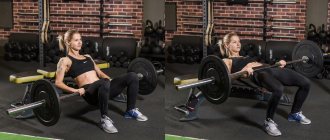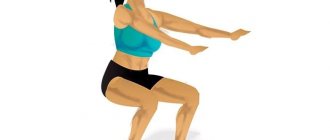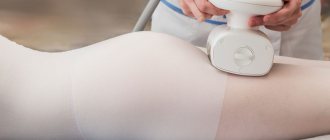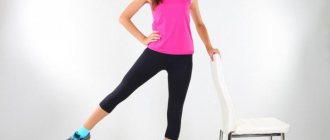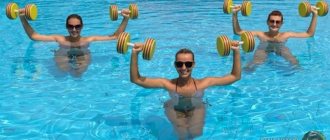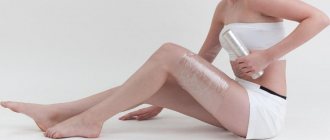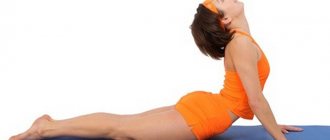The absence of excess weight does not always guarantee a slim and fit body. If you are not satisfied with your own silhouette, then yoga exercises for the legs and buttocks will help improve your position. Dissatisfaction with your figure can be caused by the presence of subcutaneous fat, which accumulates in “problem” areas. It makes the skin more flabby and provokes loss of muscle tone. The formation of subcutaneous fat can be caused by a lack of physical activity and a sedentary lifestyle.
You can cope with the problem even at home. If you correctly create a yoga exercise program and follow a certain diet, you will be able to tone the muscles in the desired areas.
Why yoga? Properly chosen exercises guarantee not only achieving the intended goal, but also increasing skin elasticity, excellent stretching, strengthening muscles, and normalizing metabolic processes. Yoga allows you to achieve perfect stretching, strengthens the musculoskeletal and ligamentous systems, gives good spirits and a great mood for the whole day.
How is yoga different from fitness?
Today, yoga classes are offered in many fitness centers. It is important to understand that there is a huge difference between fitness and mastering asanas. Fitness is primarily about working the muscles, while yoga classes have an element of meditation: the atmosphere in the room, dim lighting, and breathing exercises set you up to achieve harmony.
Yoga classes are designed so that participants achieve peace of mind, and not just exercise the body. In yoga, one learns to properly communicate with one’s own body, which becomes a tool for achieving a harmonious state. The loads in yoga are often less than in standard fitness (strength, cardio, interval training), but they are still sufficient to improve health.
Exercises for hips and buttocks
Yoga for hips and buttocks is a set of asanas that help work out problem areas. The complex must be repeated daily or every other day, especially if you are a beginner. This will allow you to achieve optimal results in a fairly short period of time. Exercises help prevent the accumulation of fat deposits, achieve mental balance and better physical shape. It is enough to devote 30 minutes of free time a day to exercise.
Flow yoga instructor Alexandra Shumkova demonstrates how to perform the exercises correctly.
Utkatasana
This asana involves engaging the muscles of the lower limbs. The maximum load falls on the hips and buttocks. To get into the correct starting position, imitate sitting on a chair. In fact, there shouldn’t be a chair under you, so we use our imagination. Since there is no support under the body, the body begins to actively engage the muscle groups of the hips and pelvis. The asana helps improve muscle tone, strengthening and training.
The starting position is called Tadasana. Smoothly bending your knees, you need to gradually lower your pelvis. You perform the movement as if you were sitting on a chair or armchair. As you inhale, you need to extend your arms above your head. It is enough to maintain this position for two or three respiratory acts. It is important to control proper breathing. A few seconds after starting the exercise, you should straighten up, returning to your starting standing position.
Note! Always listen to how your body responds to a particular exercise. Try to go as low as possible and gradually increase the depth. If the pose is easy enough for you, try standing on your toes. This will make stretching muscle fibers more effective.
Virabhadrasana II
Yoga for the hips helps to effectively work out the legs. In this case, the maximum load will be applied to the inner thigh. This feature can confidently be called the main advantage of the asana. At first glance, the exercise may seem quite simple, but it is not. It helps to work those muscles that we practically do not use in everyday life.
To begin performing the asana, you should spread your legs wider than your hips.
The right leg should be turned outward. The left leg also actively works to maintain balance. The legs should be placed so that the center of the left foot is in line with the right. By straightening your arms to the sides, you expand your chest. The pelvis should be lowered. The arms should form a single line with the shoulders and be directed forward. The occupied position must be constantly monitored to prevent deviations from it. Breathing should be strong enough, but slow. After completing the exercise, you should relax and then repeat it on the other side.
Note! To achieve the best results, you need to constantly work on stretching. The pose should be balanced and collected. The pelvis should be lowered as low as possible.
Ushtrasana
This asana provides effective opening of the chest as well as the hip flexors. By regularly repeating the pose, you will be able to keep your entire body in good shape. This exercise is aimed primarily at stimulating and stretching the muscle fibers of the thighs.
To begin performing, you need to take Vajrasana. The torso and hip part must be positioned so that the calf and thighs form a right angle with each other. By bending forward, you help yourself open your chest. As you stretch your arms, try to touch your feet with your palms. The head must be tilted back (if you have strong neck muscles and there are no problems in the cervical spine), and the movements should be smooth and careful. While holding the pose, you should relax and breathe deeply.
Upavistha Konasana
To keep your upper legs toned, you need to perform this asana regularly. It also helps improve stretching by engaging the inner thigh muscles. When performing most exercises, minimal attention is paid to them.
To begin the exercise, you should sit in Dandasana. Legs in a sitting position should be spread as wide as possible. If you can’t achieve your goal right away, trainers advise spreading your legs gradually. This must be done carefully, taking care of joints and ligaments. Your arms must be extended so that they are between your legs - in front. If you have good flexibility, try to gently bend your body and touch the floor with your head. If this fails, just relax your neck and bend your elbows, leaving your head hanging. After taking a few breaths, you can gradually return to the starting position.
Janu Sirsasana
This asana is focused on developing flexibility in the articulation of the hips and pelvis. The pose provides excellent stretching of muscle tissue and helps activate blood circulation in the tissues. By doing exercises regularly, you can keep your pelvic muscles toned and get in good physical shape.
To perform the asana, you need to take Dandasana. The left knee should be bent so that the foot is pressed against the inner thigh of the right leg. The arms should be extended upward and the body should be bent. It is necessary to place your stomach on your thigh and reach with your hands towards your right foot, while making sure that your back is as straight as possible. If you lack preparation, you can slightly bend your leg at the knee. The air should be inhaled with the stomach. Having frozen in this position for a few seconds, you can return to the original position and change sides.
Note! To perform the asana, you need to touch your head to the knee joint. It is quite difficult to do this without physical training, so you should do everything gradually. Stretch as far as you can.
Top 7 asanas for toned buttocks at home
Have you ever heard of yoga butts? If you see them once, you will definitely want the same ones. Such buttocks are elastic and beautifully shaped. A certain set of asanas will help you achieve your goal. We have put together a set of 7 effective asanas for practicing at home.
When we talk about yoga, we mean exercises that relax the body and mind. However, in addition to this, yoga practice can also serve to strengthen muscles. Every girl wants to have a beautiful, toned butt. Together with elastic buttocks you will gain self-confidence. Below are asanas that will help you achieve the desired results.
Yoga for buttocks – 7 effective asanas
- Salabhasana (Grasshopper Pose);
- Purvottanasana (Inverted Plank Pose);
- Anjaneyasana (Crescent Moon Pose);
- Virabhadrasana 2 (Warrior Pose 2);
- Trikonasana (Triangle Pose);
- Ardha Chandrasana (Crescent Moon Pose);
- Natarajasana (King of Dance Pose).
Salabhasana (Grasshopper Pose)
Salabhasana or Grasshopper Pose looks quite simple to perform, but is actually quite difficult to do correctly. It is necessary to include this asana in your training to achieve results. Practice Salabhasana in the morning on an empty stomach. This asana belongs to the basic level of Vinyasa yoga. Hold it for at least 30-60 seconds.
Benefits: Salabhasana activates the work of the whole body. Stimulates internal organs and improves blood circulation. Grasshopper pose will tone your thighs, calves and leg muscles. This asana improves metabolism and helps you lose weight.
Purvottanasana (Inverted Plank Pose)
Purvottanasana or Inverted Plank Pose is an intense stretching of the front of the body. It is best to practice it in the morning on an empty stomach. If it is not possible to perform the asana in the morning, then you can do it in the evening, but provided that the last meal was 4-6 hours ago. Maintain the asana for 30-60 seconds. This asana belongs to the basic level of Vinyasa yoga.
Benefits: Purvottanasana strengthens the muscles of the back and legs, stretches the front of the lower leg and tones the entire body. Also strengthens the core muscles.
Anjaneyasana (Crescent Moon Pose)
Anjaneyasana or Crescent Moon Pose is named after the deity Hanuman, the hero of the Ramayana. Practice the asana in the morning on an empty stomach or in the evenings 4-6 hours after your last meal. The asana belongs to the basic level of Vinyasa yoga. Maintain the asana for 15-30 seconds.
Benefits: Anjaneyasana helps develop balance and is a good stretch for the thigh muscles. Improves concentration and gives energy to the body, stimulates digestive processes.
Virabhadrasana 2 (Warrior Pose 2)
Virabhadrasana 2 or Warrior Pose 2 is named after Virabhadra, the mythical hero created by the deity Shiva. This graceful pose symbolizes the victories of mythical warriors. Virabhadrasana 2 belongs to the initial level of Vinyasa yoga. It is best to practice it in the morning on an empty stomach. Maintain the asana for at least 30 seconds.
Benefits: Warrior pose strengthens and stretches the leg muscles. Improves endurance, relieves back pain and improves posture. Gives strength and energy to the organzyme.
Trikonasana (Triangle Pose)
Trikonasana or Triangle Pose is so named because it resembles a triangle. Refers to the initial level of Vinyasa yoga. You should maintain the asana for at least 30 seconds. Unlike most other asanas, Trikonasana should be performed with open eyes to maintain balance. Practice the asana in the morning on an empty stomach.
Benefits: Trikonasana strengthens the knees, legs, legs, and improves overall physical condition. Helps improve digestion, reduces blood pressure and fights fat in the waist and hips.
Ardha Chandrasana (Crescent Pose)
Ardha Chandrasana or Crescent Moon Pose activates the lunar energy in our body. The asana belongs to the basic level of Hatha yoga. It is best practiced at dawn or dusk on an empty stomach. Maintain the asana for at least 15-30 seconds.
Benefits: the asana strengthens the muscles of the thighs, lower legs, and stretches the calves. Improves concentration and coordination. Relieves stress and improves digestion.
Natarajasana (King of Dance Pose)
Natarajasana or King of Dance Pose, when performed correctly, resembles one of the dance poses of the Hindu deity Shiva. Refers to the intermediate level of Vinyasa yoga. Practice the asana early in the morning on an empty stomach or in the evening 4-6 hours after your last meal. Maintain the asana for 15-30 seconds.
Benefits: Natarajasana is one of the best yoga poses for strengthening the buttocks. Speeds up metabolism, promotes weight loss, improves coordination and concentration.
These asanas will help you achieve the buttocks of your dreams. Now let's answer frequently asked questions.

